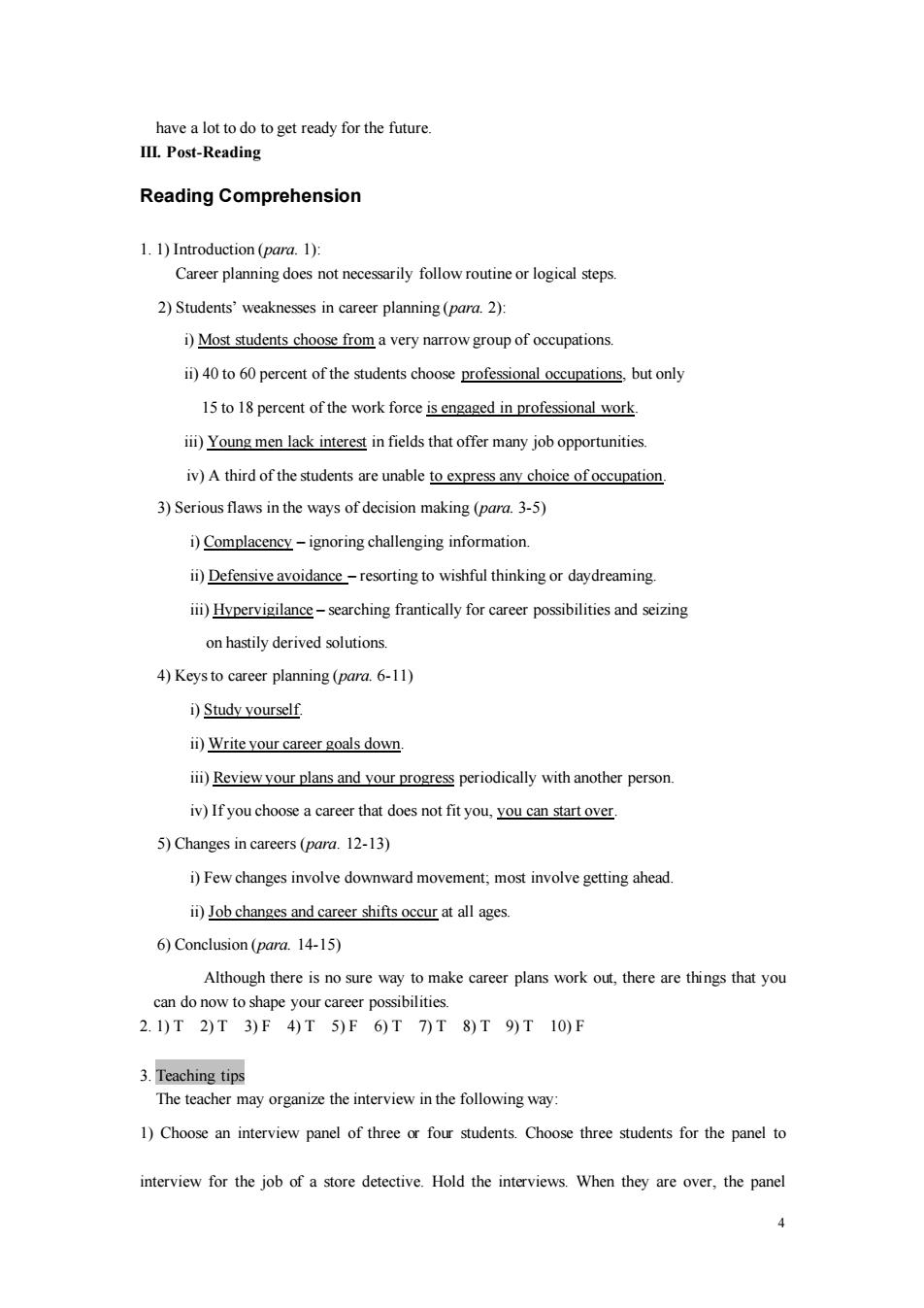正在加载图片...

have a lot to do to get ready for the future. III.Post-Reading Reading Comprehension 1.1)Introduction (para.1): Career planning does not necessarily follow routine or logical steps. 2)Students'weaknesses in career planning(para.2): i)Most students choose from a very narrow group of occupations. ii)40 to 60 percent of the students choose professional occupations,but only 15 to 18 percent of the work force is engaged in professional work. iii)Young men lack interest in fields that offer many job opportunities. iv)A third of the students are unable to express any choice of occupation. 3)Serious flaws in the ways of decision making (para.3-5) i)Complacency-ignoring challenging information ii)Defensive avoidance-resorting to wishful thinking or daydreaming. iii)Hypervigilance-searching frantically for career possibilities and seizing on hastily derived solutions. 4)Keys to career planning (para.6-11) i)Study yourself. ii)Write your career goals down. iii)Review your plans and your progress periodically with another person. iv)If you choose a career that does not fit you,you can start over. 5)Changes in careers (para.12-13) i)Few changes involve downward movement;most involve getting ahead. ii)Job changes and career shifts occur at all ages. 6)Conclusion (para.14-15) Although there is no sure way to make career plans work out,there are things that you can do now to shape your career possibilities. 2.1)T2)T3)F4)T5)F6)T7T8)T9)T10)F 3.Teaching tips The teacher may organize the interview in the following way: 1)Choose an interview panel of three or four students.Choose three students for the panel to interview for the job of a store detective.Hold the interviews.When they are over,the panel4 have a lot to do to get ready for the future. III. Post-Reading Reading Comprehension 1. 1) Introduction (para. 1): Career planning does not necessarily follow routine or logical steps. 2) Students’ weaknesses in career planning (para. 2): i) Most students choose from a very narrow group of occupations. ii) 40 to 60 percent of the students choose professional occupations, but only 15 to 18 percent of the work force is engaged in professional work. iii) Young men lack interest in fields that offer many job opportunities. iv) A third of the students are unable to express any choice of occupation. 3) Serious flaws in the ways of decision making (para. 3-5) i) Complacency – ignoring challenging information. ii) Defensive avoidance – resorting to wishful thinking or daydreaming. iii) Hypervigilance – searching frantically for career possibilities and seizing on hastily derived solutions. 4) Keys to career planning (para. 6-11) i) Study yourself. ii) Write your career goals down. iii) Review your plans and your progress periodically with another person. iv) If you choose a career that does not fit you, you can start over. 5) Changes in careers (para. 12-13) i) Few changes involve downward movement; most involve getting ahead. ii) Job changes and career shifts occur at all ages. 6) Conclusion (para. 14-15) Although there is no sure way to make career plans work out, there are things that you can do now to shape your career possibilities. 2. 1) T 2) T 3) F 4) T 5) F 6) T 7) T 8) T 9) T 10) F 3. Teaching tips The teacher may organize the interview in the following way: 1) Choose an interview panel of three or four students. Choose three students for the panel to interview for the job of a store detective. Hold the interviews. When they are over, the panel